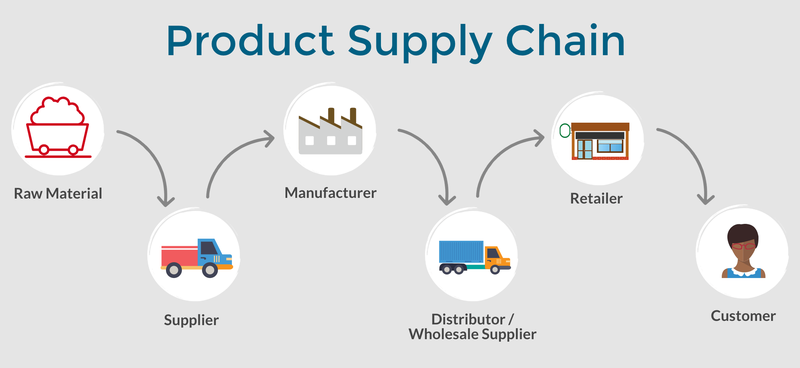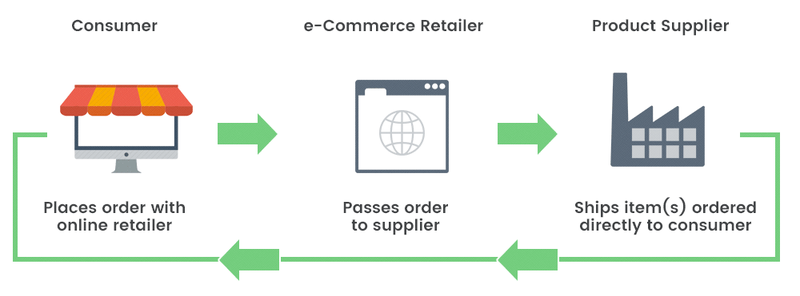When I was a kid, my dad used to regularly offer me the same unsolicited advice, “Buy low, sell high.” It wasn’t until I was a book publisher calculating the retail prices of our books that I understood what he was saying: A completed business transaction doesn’t guarantee you’ve made a profit on it.
You’ll go broke fast if you don’t buy your products at a low enough wholesale price to generate an adequate profit from your own retail sales.
Let’s go over the multiple benefits of buying wholesale, the differences between wholesale and dropshipping suppliers, and five ways to find the best wholesale companies for your small business.
Overview: What is wholesale?
Wholesale purchasing occurs when businesses buy discounted products in bulk to resell at higher prices to consumers or other businesses. Companies typically work with a wholesale distributor, which makes purchasing more efficient because you don’t deal with multiple individual manufacturers.
Wholesale purchasing is one step within the larger product supply chain, which starts with raw materials and ends with a customer’s purchase.

For example, the U.S. has hundreds and maybe thousands of book publishers, and no bookstore has the time or resources to deal with each one individually. Instead, about half a dozen major book distributors stock books from these publishers to sell to single bookstores or bookstore chains.
What is wholesale pricing?
The amount you pay a wholesaler, distributor, or manufacturer for a product is the wholesale price. Wholesalers use a sliding scale for per-unit prices based on the order amount, so the bigger the order, the larger the discount.
While you can obtain lower per-unit wholesale prices through larger volume purchases, chasing these discounts can have a downside — the ongoing cost of storing goods you’re not selling. Use the economic order quantity (EOQ) formula to determine how many units you should buy based on past sales.
Wholesale vs. dropshipping: What’s the difference?
Wholesale buying is sometimes conflated with dropshipping — both involve selling discounted products at retail prices to consumers — but the two use different processes.
Wholesale purchases require the retailer to buy stock to have on hand before making a sale. With dropshipping, the retailer never sees or handles the products sold. Instead, the customer places an order with the retailer, usually online, and the retailer relays it to the product’s supplier, who ships it to the customer.

Dropshipping is attractive to online merchants because there are no warehousing costs, they aren’t stuck with inventory that doesn’t sell, and suppliers pick, pack, and ship orders.
Profit margins are smaller, however, because product suppliers are responsible for order fulfilment and warehousing. Merchants’ reputations are also at the mercy of these suppliers, who are responsible for timely delivery of the correct, high-quality products.
Benefits of buying wholesale
Wholesale purchasing allows you to reduce per-unit costs, but you’ll enjoy extra benefits once you develop a reliable network of suppliers. These will impact your most important key performance indicator (KPI) — the bottom line.
1. Lower costs
As you lower your unit costs with wholesale purchases, related expenses go down. Larger orders — a pallet or more of products — can significantly drop your shipping prices. You’ll also make purchases less often, which further reduces shipping overhead.
Buying from wholesalers reduces your administrative costs because you deal with a handful of suppliers instead of 10 or 20 or more individual manufacturers. The best point-of-sale (POS) systems include POS inventory management that automatically orders stock once levels drop to preset levels.
2. Better product selection
Wholesale buying gives you a wider product selection to choose from. If you own your bookstore, working with one or two book distributors lets you stock books from the big five U.S. publishing companies and hundreds of independent presses.
To compete with Amazon, you must provide a customer experience that online buying doesn’t offer, but you can stock the same national bestsellers and classics many readers want.
3. Ability to scale up
Wholesale buying lets you scale up your business as it grows. If you sell retail apparel and set up another location, adding inventory only requires a larger order from your wholesale clothing supplier.
Or, if sales of a particular product or product line spike, your established relationships with suppliers will allow you to keep inventory in stock.
How to find wholesale suppliers for your small business
When your business is ready to work with wholesale suppliers, don’t rush into any agreements or contracts. Do your research and consult with your industry peers to make sure you find the best deal for your small business.
Step 1: Assess your needs and resources
Buying wholesale can save money and increase your profit margins, but you must assess multiple factors to leverage these benefits to best effect.
Areas to examine include:
• Sales history: Do you have the sales to justify buying wholesale? Your POS terminal does more than accept credit card payments; it also tracks your sales. Most wholesalers have minimum purchase amounts, so you need to identify the products best suited for bulk sales.
• Warehousing: Where are you going to store your bulk purchases? Can you do this on-site or will you store products elsewhere? Don’t forget these storage costs add to the wholesale unit price. Inventory management POS features will help you determine how much space you need.
• Projected sales: The POS data your POS hardware and virtual terminal collect help project future sales. Are your projected sales large enough to cover storage costs and avoid potential losses due to perishable items or those with a limited lifespan? A great deal on 2020 calendars isn’t so good once the end — or even the middle — of the year arrives, and you have a pallet of them still sitting in your warehouse.
Don’t underestimate the storage space you’ll need. Nothing is worse than having a shrink-wrapped pallet of goods delivered to your store or office and realizing you have no place to put it.
I used to work for a small craft beer brewery, and when it needed more storage space, the owners bought a used shipping container they dropped outside the brewery in the parking lot. However, not everyone has that luxury.
Step 2: Research your industry
Every industry has its own product supply chains and wholesale supplier networks. Nothing beats old-fashioned research to discover the ins and outs of your market sector, whether it’s running a restaurant, selling clothes, or serving craft beer in a taproom.
Methods to research your industry’s wholesalers include:
• Business-to-business (B2B) marketplaces: Alibaba is the world’s largest online B2B sales website, and you can find everything from shirts to tractors to electronics and a whole lot more. You can also choose from other B2B marketplaces, and some research may turn up ones that specialize in your industry.
• Industry trade publications: Wholesalers want to find you, and one method they use is advertising in trade magazines. Find the best publications in your industry and subscribe to them. Not only will you discover wholesalers, you’ll stay up to date on current industry news.
• Business directories: Multiple business databases are available with information about virtually every company worldwide. The cost to access them on your own can be expensive, but many, such as ReferenceUSA, are available at many public libraries.
When I got into book publishing, I realized there was plenty I didn’t know. I found the best resources I could to study, which included “Publishing for Profit: Successful Bottom-Line Management for Book Publishers.”
It was an invaluable resource covering the entire trade book publishing industry, with information about wholesale and retail pricing, book distributors, and more. And if it didn’t have the answers I needed, it steered me to where I could find them.
Step 3: Network within your industry
No man is an island, so learning first-hand about best practices in general and wholesaling in particular is a good reason to actively network with your industry peers.
Networking opportunities include:
• Local competitors: You probably shouldn’t walk up to someone you haven’t met or barely know and say, “Hey, tell me all about your wholesale purchasing.” Everyone loves to talk shop, however, so get to know your local competition to cultivate at least a professional relationship.
• Business networks: Local business networks include your chamber of commerce, Small Business Administration (SBA) community groups, and Service Corps of Retired Executives (SCORE), a nationwide network of business mentors. Join your national trade association(s) to participate in networking events, online forums, and other informational opportunities.
• Online networking: Facebook and LinkedIn have industry-specific user groups where you can ask questions, help others with your expertise, and build your list of contacts.
The nature of business may be dog eat dog like Alec Baldwin’s salesman character in Glengarry Glen Ross — “Coffee’s for closers” — but many of your competitors will have an “It’s all of us versus the world” mentality.
Some of the most valuable inside information I learned and contacts I made came from generous, long-time book publishers who shared what they knew to keep the industry growing.
Step 4: Attend industry events
Industry trade shows are another valuable source of wholesale supplier information. Concentrate on B2B or industry-specific shows, which normally occur at least once a year. Joining trade associations, searching their websites, and checking industry publications will tell you when and where to go.
Tips to get the biggest return on trade shows include:
• Make a plan: Every trade show publishes a list of events — keynote speeches, panel discussions, and product demos — and a daily schedule helps you stay organized. They’ll also provide a list of exhibitors and exhibit hall map(s), so identify whom you’re interested in talking to and find out where they’ll be.
• Set up meetings: If you’re ready to make a deal, schedule meetings with vendors before the trade show. Exhibit halls are frequently loud and crowded, which is not conducive to an extended one-on-one conversation. Contact the wholesalers you’re serious about, and they should be more than willing to set up a private meeting.
Don’t make the mistake of thinking a trade show is a vacation, despite the fact they’re often held in great places to visit. But you don’t have to be a slave to the grind. Make a plan for your downtime at night or during targeted breaks so you have something to show — and bring home — besides exhibitor booth giveaways.
Step 5: Hire a consultant
It’s OK to admit you don’t know everything. Choosing a wholesaler to work with will dramatically impact your business, so you must make the right decision. If you can’t decide what to do or have questions you can’t satisfactorily answer on your own, consider hiring a consultant to help.
All consultants are not created equal, so make sure you:
• Choose carefully: Look under any rock and you’ll find an industry “expert.” Research your options before hiring anyone. What is their demonstrated industry experience? Who are their previous consulting clients? What makes them an expert?
• Identify the deliverables: What exactly will your consultant provide? A list of recommended wholesalers based on an examination of your sales? Introductions to potential suppliers? A final report?
Our book publishing operation grew to the point where we needed to make some hard choices about our future that we couldn’t afford to get wrong. I went to a presentation at a book conference by the author of “Publishing for Profit.”
After a long publishing career, he’d gone into consulting, and after hearing him speak, he seemed like a good fit for us.
Following negotiations about cost and final deliverables, he spent several days at our offices inspecting our operations from top to bottom. He made recommendations for book printers to lower our production costs and personnel to add, and he helped us sign with a national book distributor.
It was absolutely the best choice — and expenditure — we could have made at that time.
Discover the benefits of buying wholesale
If you’re not already purchasing inventory in bulk, now’s the time to begin wholesale buying. Use your POS cloud data to make smart purchases, and you could enjoy multiple benefits beyond my dad’s “buy low, sell high” maxim.
The post A Small Business Guide to Buying Wholesale appeared first on Blueprint and is written by Mark Roy Long
Original source: Blueprint




